We all know that creating the perfect play area for our kids can feel overwhelming with endless options and considerations. Whether you’re designing an indoor playroom or transforming your backyard into an adventure zone, the right play space can spark creativity, encourage physical activity, and provide hours of entertainment.
The best play areas combine safety with fun while maximizing your available space and budget. From DIY obstacle courses to interactive learning stations, we’ve discovered countless ways to create captivating environments that grow with your children’s developmental needs.
We’ll explore practical play area ideas that work for every home, yard size, and budget. You’ll discover how to transform ordinary spaces into extraordinary play zones that keep kids active, engaged, and excited to explore their industry through play.
Create a Designated Reading Nook for Quiet Play
Quiet play areas provide essential balance in active play spaces. We’ll show you how to design a cozy reading corner that encourages literacy and peaceful activities.
Choose Comfortable Seating Options
Bean bags offer versatile seating that adapts to children’s movements and preferences. We recommend selecting washable covers in neutral colors that complement your existing decor while hiding everyday stains and spills.
Floor cushions create flexible seating arrangements for multiple children or solo reading sessions. Stack them in corners when not in use or spread them across the floor for storytime gatherings with friends and siblings.
Low armchairs sized for children provide proper back support during longer reading sessions. Look for chairs with sturdy construction and easy-to-clean upholstery that can withstand daily use from energetic young readers.
Reading tents add an element of adventure to quiet time activities. Set up pop-up versions for temporary reading spaces or create permanent fort-style structures using PVC pipes and colorful fabric panels.
Add Soft Lighting and Cozy Textiles
String lights create magical ambiance that makes reading time feel special and inviting. We suggest using warm white LED versions with battery packs to avoid electrical hazards while providing gentle illumination for evening reading sessions.
Table lamps with adjustable brightness help prevent eye strain during extended reading periods. Choose models with weighted bases that won’t tip over easily and consider touch-activated options for easy operation by small hands.
Throw blankets add warmth and comfort to any seating arrangement in your reading nook. Select machine-washable materials like cotton or microfiber that maintain their softness after frequent laundering and daily use.
Area rugs define the reading space while providing soft surfaces for floor seating options. We recommend low-pile rugs that are easy to vacuum and won’t create tripping hazards for children moving in and out of the area.
Organize Books at Child-Friendly Heights
Forward-facing book displays make it easier for children to identify their favorite titles and discover new stories. Install floating shelves at heights between 24 and 36 inches to accommodate different age groups and reading abilities.
Book bins sort different genres and reading levels while keeping collections organized and accessible. Label containers with pictures and words to help pre-readers navigate their options independently and develop organizational skills.
Wall-mounted book ledges maximize vertical storage space without taking up valuable floor area. We suggest installing multiple ledges at varying heights to create visual interest while accommodating your growing book collection.
Rolling book carts provide portable storage that can move between different play areas as needed. Choose models with multiple tiers and smooth-rolling wheels that won’t scratch floors or create noise during movement.
Design an Active Indoor Climbing Zone
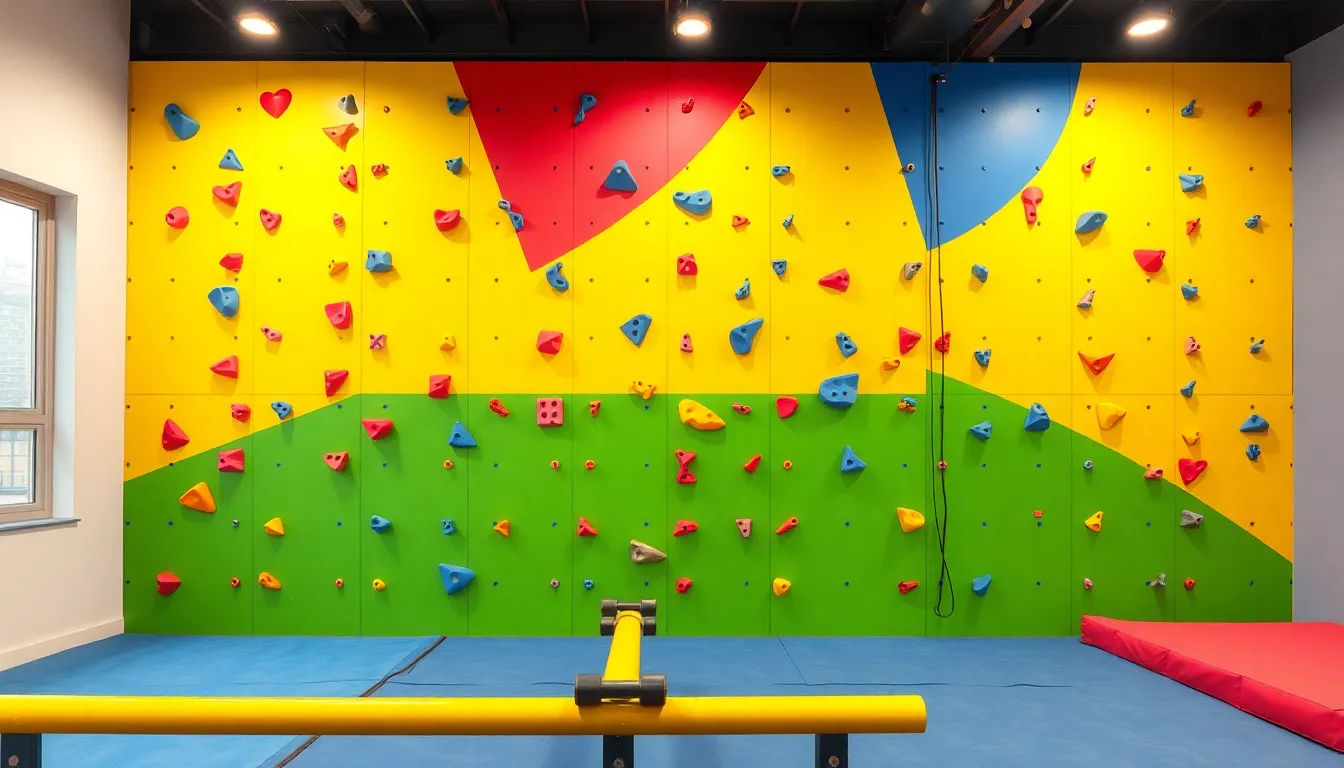
Creating an active indoor climbing zone transforms any room into an adventure playground that builds strength, coordination, and confidence. We’ll help you design a safe climbing environment that challenges kids while keeping them secure.
Install Wall-Mounted Climbing Holds
Wall-mounted climbing holds create the perfect vertical challenge for developing upper body strength and problem-solving skills. These colorful grips attach directly to your wall, allowing children to experience authentic rock climbing movements in a controlled environment.
Choose holds that match your child’s skill level – start with larger, easier grips for beginners and add smaller, more challenging ones as they progress. Bright colors like red, blue, and yellow make the climbing wall visually appealing while helping kids plan their routes.
Install holds at varying heights to accommodate different ages and abilities. Space them 12-18 inches apart horizontally and 8-12 inches vertically for optimal climbing patterns. This spacing ensures children can move naturally while maintaining proper form.
Consider modular climbing panels as an alternative to individual holds. These versatile panels can be rearranged to create varying difficulty levels, making them suitable for different ages and skill levels as your child grows.
Add Foam Mats for Safety
Foam mats provide essential cushioning that makes indoor climbing safe and worry-free for parents and children alike. These protective surfaces create a secure landing area that prevents injuries from falls during climbing adventures.
Select mats that are at least 2 inches thick to provide adequate cushioning for falls from climbing heights. High-density foam offers the best protection while maintaining durability for long-term use.
Cover the entire climbing area with interconnected foam tiles or large continuous mats. This complete coverage ensures children have a safe landing zone regardless of where they fall or jump down from their climbing structure.
Choose mats with non-slip bottoms to prevent sliding during active play. Look for options with washable covers that can handle spills, dirt, and regular cleaning to maintain a hygienic play environment.
Include Balance Beams and Obstacle Courses
Balance beams help children develop coordination and core strength while adding variety to their climbing zone experience. These simple additions create new challenges that complement climbing activities perfectly.
Start with low beams positioned 2-4 inches off the ground to build confidence before progressing to higher challenges. Adjustable height beams grow with your child’s abilities and comfort level.
Create obstacle courses that incorporate tunnels, nets, and crawling structures alongside your climbing elements. These comprehensive play experiences combine multiple movement patterns that develop different muscle groups and motor skills.
Design courses that flow naturally from one element to the next, encouraging continuous movement and creative play. Include rock climbing ramps with gentle inclines that teach balance and precision, making them ideal for beginners and experienced climbers alike.
Add climbing domes as central play features that can be combined with other climbing elements like ramps and nets. These dome-shaped structures, often made of wood, provide 360-degree climbing opportunities that challenge children from every angle.
Build a Creative Arts and Crafts Station
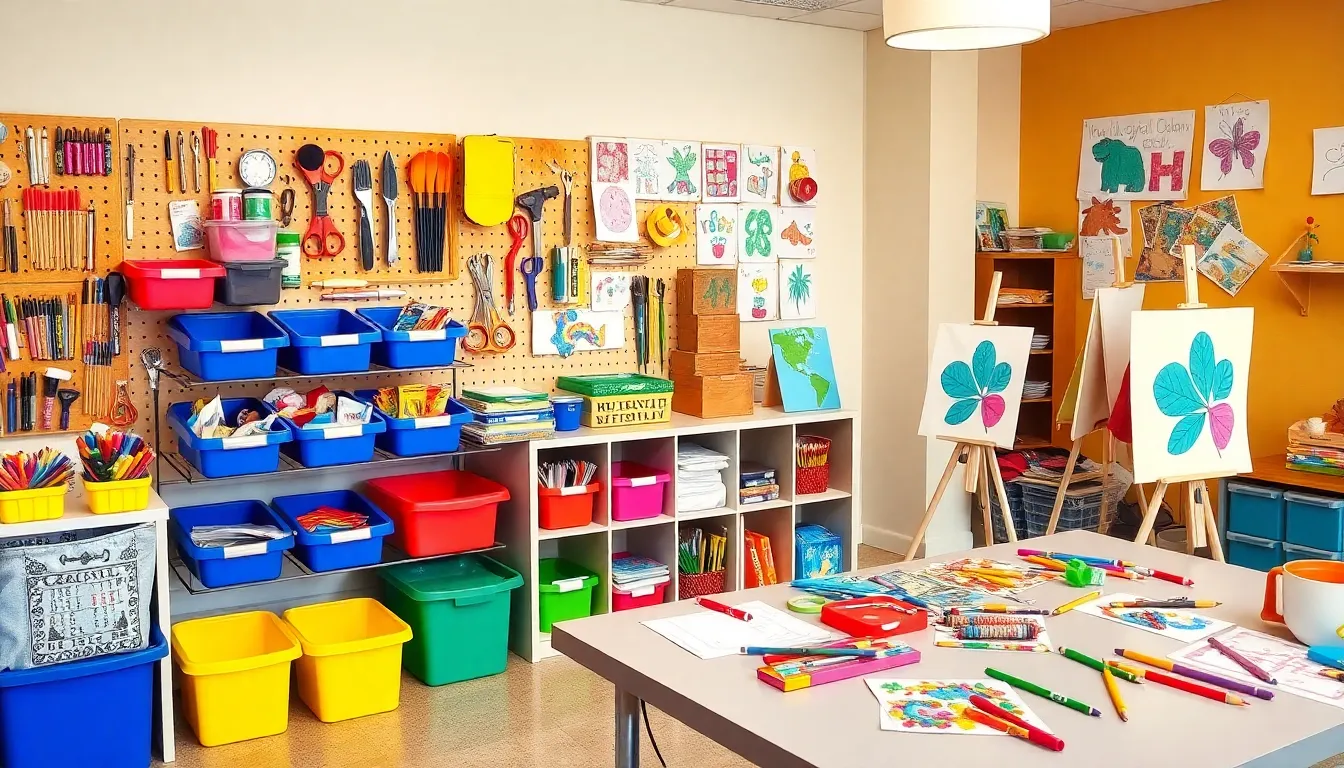
Creating a dedicated arts and crafts area encourages self-expression while keeping supplies organized and accessible. We’ll show you how to design a station that inspires creativity and maintains order through smart storage, surfaces, and display answers.
Set Up Storage for Supplies and Materials
Sort materials by type using labeled bins for paints, paper, glue, and scissors to create an organized system. Clear containers allow children to see contents at a peek, while wall-mounted organizers maximize vertical space without cluttering work areas.
Install a pegboard on the wall to display frequently used tools like scissors, rulers, and paintbrushes within easy reach. Utility carts offer mobile storage that moves with projects, making supplies accessible from any angle of the workspace.
Use labeled drawers to separate small items like beads, stickers, and markers into categories that make sense to children. We recommend checking and replenishing supplies regularly to ensure the station remains functional and inspiring for creative activities.
Provide Easy-to-Clean Work Surfaces
Choose laminate tables that resist stains and wipe clean easily, allowing children to experiment freely without permanent damage concerns. Wipeable mats provide additional protection while creating defined work zones for individual or group projects.
Add vinyl tablecloths over existing surfaces for instant protection that peels away when projects get messy. Washable placemats create personal workspaces that children can claim as their own creative territory.
Place plastic trays on surfaces to contain wet materials like paints and glue, preventing spills from spreading beyond the immediate work area. These surfaces encourage bold experimentation while maintaining easy cleanup for parents and caregivers.
Display Artwork and Finished Projects
Create wall displays using clipboards, frames, or string with clips to showcase completed artwork in an organized gallery format. Rotating pieces regularly keeps the display fresh and gives every child’s work a chance to shine.
Install floating shelves at child height to display three-dimensional projects like sculptures and create creations that need more space than flat wall displays. We suggest using these shelves to feature seasonal projects or themed collections.
Set up easels near the work area to display works in progress, helping children visualize their creative journey from start to finish. This builds pride in their artistic process while encouraging continued creativity and skill development.
Establish a Pretend Play Corner
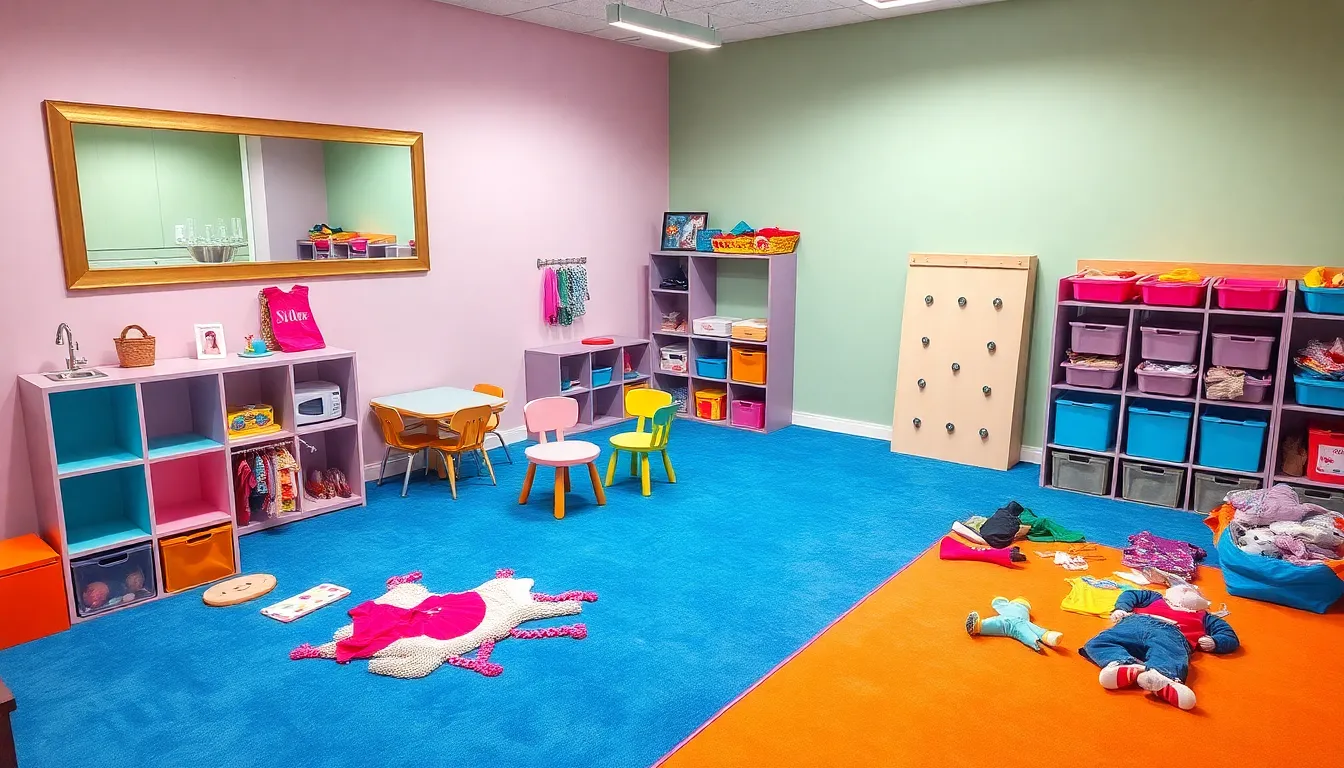
Pretend play corners transform ordinary spaces into magical worlds where children’s imaginations flourish. We’ll show you how to create dedicated areas that encourage role-playing while keeping everything organized and accessible.
Create Different Themed Play Scenarios
Transform your space with versatile pretend play essentials like miniature kitchens, doctor clinics, or shop setups. Small shelves work perfectly for storing cooking tools or pretend fruits and vegetables, keeping everything within reach for young hands.
Design an indoor climbing wall to add active elements that develop motor skills alongside imaginative play. Safety mats or soft flooring create secure landing areas while encouraging physical development.
Build a home corner using child-sized appliances, storage boxes, and mirrors to establish versatile role-play opportunities. Boundaries and privacy enhance the experience by adding curtains or folding screens that define the space and encourage deeper imaginative engagement.
Include Dress-Up Clothes and Props
Offer diverse dress-up options including hats, shoes, purses, wallets, and jewelry that reflect different roles and professions. These accessories help children explore various career paths and social situations through play.
Provide accessories for enhanced role-play such as toolboxes, lunch boxes, and telephones that bring authenticity to pretend scenarios. These props encourage children to develop storytelling abilities while practicing real-industry interactions.
Organize costume elements in easily accessible containers so children can quickly find what they need for their imaginative adventures. Clear bins or labeled storage helps maintain organization while promoting independent play choices.
Add Child-Sized Furniture and Accessories
Use low storage shelves and child-sized appliances to create inviting and interactive spaces that match children’s proportions. This furniture scale allows kids to engage naturally with their environment without adult assistance.
Install movable partitions or loft houses to define different areas within the play corner while maintaining flexibility. These dividers help separate various themed scenarios and create cozy, intimate spaces for focused play.
Position mirrors strategically throughout the pretend play area to help children see themselves in character and enhance their role-playing experience. Mirrors also make small spaces feel larger while adding visual interest to the corner.
Transform Outdoor Spaces Into Adventure Zones

We’ll explore ever-changing outdoor play answers that turn backyards into thrilling adventure destinations where children develop physical skills while exploring nature.
Install Swing Sets and Slides
Installing swing sets creates the foundation for active outdoor play that builds core strength and coordination. Traditional swings offer classic back and forth motion that children love, while rope swings add challenging grip strength development. Hammock swings provide a unique rocking experience that accommodates multiple children or allows for relaxing solo time.
Slides bring instant excitement to any outdoor space with options that match different thrill levels. Straight slides deliver quick descents perfect for younger children building confidence, while spiral slides create twisting adventures that older kids crave. Tunnel slides add mystery and anticipation as children disappear from view before emerging at the bottom with huge smiles.
Create Sandbox and Digging Areas
Building sandbox areas provides endless creative possibilities using clean, fine sand that’s safe for children’s play. We recommend adding classic toys like buckets, shovels, and molds that encourage castle building, road construction, and imaginative storytelling. Sandbox play develops fine motor skills while offering sensory experiences that calm and focus active minds.
Digging areas expand exploration opportunities beyond traditional sandboxes using soft materials like wood chips or mulch. These designated zones satisfy children’s natural urge to dig and discover while protecting other garden areas. Digging activities strengthen hand muscles, improve coordination, and provide therapeutic benefits for children who need sensory input.
Add Nature Exploration Elements
Nature inspired play structures seamlessly blend adventure with environmental learning through creative design elements. We suggest incorporating butterfly wings or vine patterns into swing and slide designs that spark conversations about wildlife and ecosystems. These artistic touches transform ordinary equipment into storytelling props that fuel imaginative adventures.
Balance beams using natural materials like tree stumps or logs create woodland trail experiences right in your backyard. Children develop coordination and confidence while handling these organic obstacle courses that change with weather and seasons. DIY obstacle courses featuring winding garden paths with stepping stones, stumps, and tunnels provide endless entertainment that adapts to growing skill levels.
Set Up Sensory Play Experiences
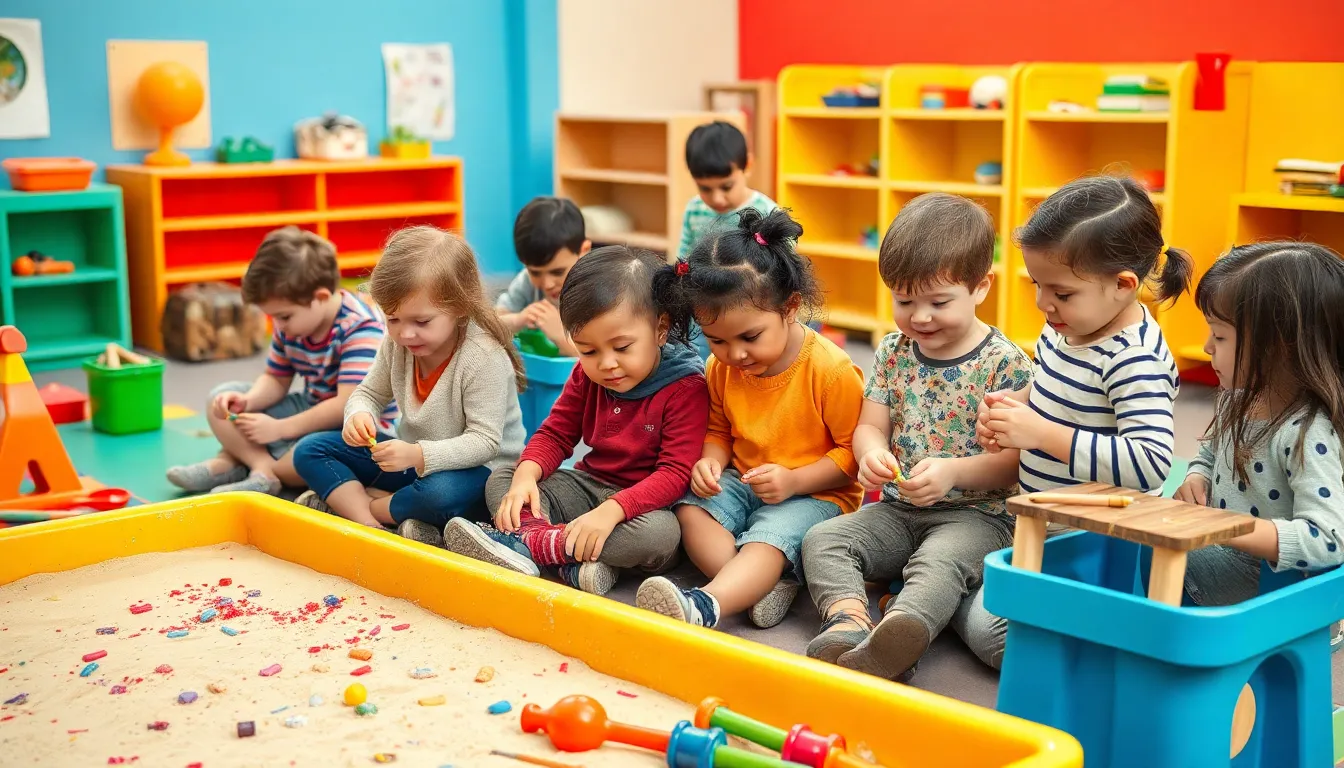
Creating sensory rich environments transforms ordinary play areas into ever-changing learning spaces that engage multiple senses simultaneously. We’ll explore how to design interactive stations that captivate children through touch, sound, and tactile exploration.
Include Different Textures and Materials
Tactile mats create the foundation for varied sensory floor experiences using foam, rubber, or fabric materials that children can walk, crawl, or sit on. Natural elements like wood, stone, or plants add diversity to the play area while connecting kids to organic textures and materials. Sensory walls using buttons, sandpaper, pom poms, artificial grass, and seashells provide rich tactile experiences that children can explore with their hands and fingers.
Incorporating different fabric swatches, textured panels, and raised surfaces gives children opportunities to compare smooth versus rough sensations. Rotating materials seasonally keeps the sensory experience fresh and introduces new textures like pinecones in fall or smooth river rocks in summer. Mounting various textured boards at different heights ensures accessibility for children of all ages and developmental stages.
Create Water and Sand Play Stations
Water tables offer endless opportunities for pouring, measuring, and exploring with water through hands on activities that develop fine motor skills. Sandboxes equipped with various tools for digging, building, and mold making provide tactile experiences that engage creativity and sensory exploration. Adding measuring cups, funnels, and containers to water stations enhances the learning potential while keeping children engaged.
Setting up both wet and dry sensory bins allows children to experience different consistencies and textures throughout their play sessions. Including scoops, brushes, and molds in sand play areas encourages tool use and develops hand eye coordination. Covering sandbox areas when not in use protects the sand from debris while maintaining clean play conditions.
Add Musical Instruments and Sound Elements
Sound stations featuring drums, xylophones, or chimes foster auditory exploration while developing rhythm and musical awareness in children. Wind chimes and other sound emitting objects enhance the auditory experience by responding to movement and air currents throughout the play space. Creating dedicated music corners with age appropriate instruments encourages independent musical discovery and creative expression.
Installing wall mounted sound panels with different tones and textures provides interactive auditory experiences that children can control. Incorporating bells, shakers, and rain sticks into sensory bins combines tactile and auditory stimulation for multi sensory engagement. Positioning musical elements at various heights ensures all children can access and enjoy the sound making opportunities.
Design Age-Appropriate Learning Centers
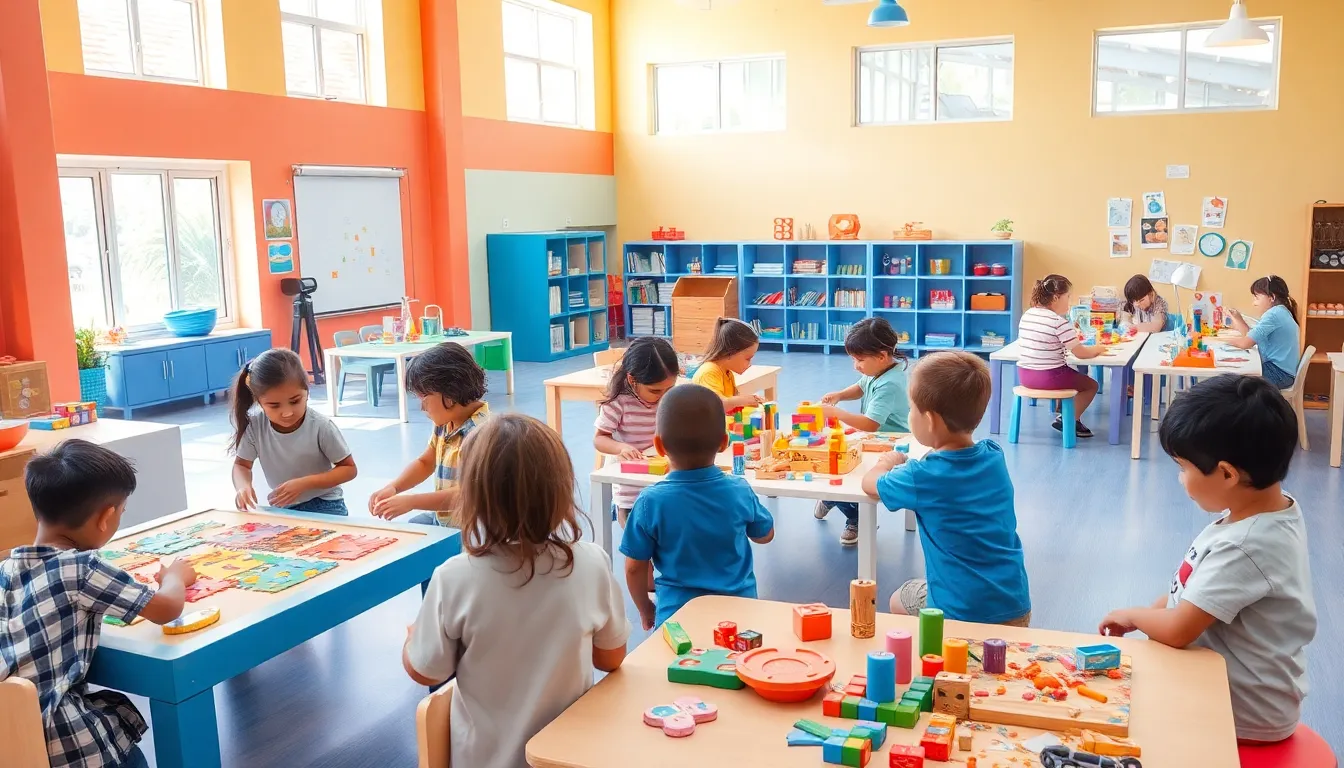
Learning centers transform our play spaces into environments that support cognitive development while keeping children engaged. We’ll create zones that match our children’s developmental stages and learning needs.
Organize Educational Toys by Skill Level
Categorize toys based on developmental abilities to ensure each child finds appropriate challenges that build their confidence. We group similar toys together like puzzles for problem-solving, manipulatives for fine motor skills, and building sets for spatial reasoning.
Label storage areas clearly with both pictures and words so children can independently choose activities that match their interests and abilities. This system helps us maintain organization while teaching kids responsibility for their play materials.
Rotate toys regularly to maintain interest and introduce new challenges as children’s skills develop. We keep advanced toys accessible but separate from beginner options to prevent frustration and encourage natural progression.
Create skill-based stations where children can progress from simple to complex activities within the same area. For example, we might arrange shape sorters for toddlers next to pattern blocks for preschoolers in the same manipulative zone.
Create Puzzle and Building Block Areas
Set up dedicated puzzle tables with comfortable seating and good lighting to enhance problem-solving experiences. We provide puzzle boards or trays that keep pieces contained and make cleanup easier for young children.
Include various puzzle types ranging from simple wooden knob puzzles to complex jigsaw puzzles with hundreds of pieces. This variety ensures every child finds puzzles that challenge their current abilities while offering room for growth.
Design building block stations with different construction materials like wooden blocks, magnetic tiles, and interlocking bricks such as LEGO and Duplo. We organize blocks by size and type in clear containers so children can easily access what they need for their creations.
Provide building inspiration through picture books, example models, or challenge cards that spark creativity and spatial reasoning. We also include measuring tools and planning sheets for older children who want to design before they build.
Include STEM Activity Stations
Incorporate hands-on science experiments using simple materials like magnifying glasses, measuring cups, and safe chemicals for basic reactions. We set up experiment stations with clear instructions and safety equipment appropriate for each age group.
Create coding and technology areas with age-appropriate programming toys, tablets with educational apps, and simple robotics kits. These stations introduce computational thinking through play-based learning that feels natural and captivating.
Set up engineering challenges using everyday materials like cardboard tubes, tape, and recyclables for building bridges, towers, and simple machines. We provide challenge cards with exact goals like “build a bridge that holds 10 blocks” to guide exploration.
Design interactive math stations with manipulatives, counting games, and geometric shapes that make abstract concepts concrete and understandable. We use visual displays and interactive tools to teach concepts like geometry and physics principles through hands-on exploration.
Maximize Small Spaces With Multi-Purpose Solutions

Small spaces don’t have to limit our children’s play opportunities. We can transform even the tiniest areas into ever-changing play environments using smart answers that serve multiple functions.
Use Vertical Storage and Wall-Mounted Options
Vertical shelves transform our walls into organized storage systems that keep toys and supplies accessible while clearing floor space for active play. We can install floating shelves at different heights to accommodate various toy sizes and our children’s growing reach. Wall-mounted hooks provide instant storage for dress-up clothes, backpacks, and play accessories without taking up valuable floor real estate. Pegboards offer customizable storage answers where we can hang baskets, small bins, and even lightweight toys. Corner shelving units maximize those often-forgotten spaces while providing display areas for favorite books and games.
Choose Furniture That Doubles as Storage
Storage ottomans serve as comfortable seating during storytime while hiding toys, art supplies, and games inside their spacious compartments. We can position these versatile pieces throughout the play area to create flexible seating arrangements that adapt to different activities. Multi-purpose tables with built-in storage compartments keep create supplies organized and within reach during creative projects. Bench seating with lift-up tops provides comfortable spots for putting on shoes while storing outdoor toys and sports equipment underneath. Coffee tables with lower shelves create display space for current favorites while keeping backup toys readily available.
Create Convertible Play Areas
Modular furniture pieces like play sofas can be rearranged into different configurations for various activities, from fort building to movie watching. We can transform these flexible pieces into obstacle courses, cozy reading nooks, or collaborative play spaces depending on our children’s needs. Flexible play mats serve as defined activity zones that can be easily moved to accommodate different play scenarios throughout the day. Folding room dividers help us create separate play zones when needed and can be stored flat against walls when we want an open floor plan. Pop-up play tents and collapsible playhouses provide instant hideaways that can be set up quickly and stored compactly when not in use.
Ensure Safety and Childproofing Measures

Creating a safe play environment requires careful attention to potential hazards and protective measures. We must carry out multiple layers of safety features to transform any space into a secure area where children can explore freely.
Install Proper Flooring and Padding
Proper surface materials form the foundation of playground safety and injury prevention. We recommend installing at least 12 inches of wood chips, mulch, sand, or pea gravel around all play equipment to cushion potential falls. Safety-tested rubber mats provide another excellent option that meets protective standards while offering easy maintenance.
Accessibility features ensure every child can enjoy the play area regardless of their abilities. We should create smooth pathways that accommodate wheelchairs and other mobility devices. Level surfaces prevent tripping hazards, so we maintain slopes less than 5% throughout the entire play zone.
Ground preparation requires attention to drainage and stability. We select materials that won’t compact over time or create uneven surfaces that could cause accidents. Regular maintenance of these protective surfaces keeps them effective and safe for daily use.
Secure Heavy Items and Sharp Edges
Heavy equipment poses serious risks if not properly anchored to prevent tipping or falling. We secure all large play structures using appropriate mounting hardware that can withstand the forces of active play. Installation methods vary depending on the surface type, whether concrete, soil, or indoor flooring.
Sharp edges and pointed corners require immediate attention during setup and regular inspections. We ensure all equipment corners are rounded and any sharp points are covered with protective materials. Hardware components must be smooth and cannot be loosened without tools to prevent tampering.
S-hooks and connecting elements need special attention to prevent finger injuries. We maintain gaps less than 0.04 inches in S-hooks to eliminate pinching hazards. Regular inspections catch loose bolts or worn components before they become safety risks.
Maintain Clear Sight Lines for Supervision
Unobstructed views allow parents and caregivers to monitor children’s activities from multiple vantage points. We design play areas free of large structures that block sight lines, ensuring continuous visual supervision of all play zones. Strategic placement of equipment creates natural supervision points throughout the space.
Separate areas for different age groups reduce conflicts and age-inappropriate equipment use. We create distinct zones with clear signage that indicates recommended age ranges for each section. Physical barriers or visual cues help children understand which areas are designed for their developmental stage.
Site selection impacts supervision effectiveness, so we choose shaded, well-maintained areas with minimal natural hazards. When streams, cliffs, or other dangers exist nearby, we ensure the entire site is fully fenced with secure gates. Regular maintenance removes debris and potential hazards that could obstruct views or create new safety concerns.
Conclusion
Creating the perfect play area doesn’t require a massive budget or unlimited space. We’ve shown you that with thoughtful planning and creative answers you can transform any area into an captivating environment that supports your child’s development.
The key lies in balancing different types of play experiences while prioritizing safety and functionality. Whether you’re working with a small apartment corner or a spacious backyard you now have the tools to design spaces that grow with your children.
Remember that the best play areas evolve over time. Start with one or two elements that excite your family most then gradually build upon your foundation. Your investment in creating these special spaces will pay dividends in countless hours of joy learning and cherished childhood memories.
Frequently Asked Questions
What are the key elements of an ideal play area for children?
The ideal play area combines safety and fun while maximizing available space and budget. Essential elements include quiet spaces like reading nooks, active zones with climbing features, creative arts stations, and pretend play corners. The area should promote creativity, physical activity, and exploration while incorporating proper safety measures like soft flooring and secure equipment installation.
How can I create a cozy reading nook for my child?
Design a comfortable reading corner using bean bags, floor cushions, or small chairs. Add a reading tent for extra coziness and install soft lighting for ambiance. Organize books at child-friendly heights using low shelves, wall-mounted displays, or book bins. Keep the area quiet and separate from active play zones to encourage focused reading time.
What safety measures should I consider for indoor climbing zones?
Install wall-mounted climbing holds securely and place thick foam mats underneath to cushion falls. Ensure proper wall anchoring that can support your child’s weight plus additional force. Add balance beams and obstacle courses with rounded edges. Regularly inspect all equipment for wear and maintain clear sight lines for supervision during play.
How do I organize an arts and crafts station effectively?
Use smart storage solutions like clear bins, drawer organizers, and labeled containers to keep supplies accessible. Choose easy-to-clean work surfaces like wipeable tables or washable mats. Display children’s artwork on walls or bulletin boards to celebrate creativity. Store frequently used items at child height and rotate materials to maintain interest.
What makes a good pretend play corner?
Create themed scenarios with child-sized furniture like mini kitchens, toy stores, or doctor offices. Provide dress-up clothes and props in organized storage boxes or costume racks. Use open shelving and clear containers so children can independently choose materials. Rotate themes periodically to keep imaginative play fresh and engaging.
How can I transform my backyard into an adventure zone?
Install swing sets and slides that build core strength and coordination. Create sandbox areas for sensory play and digging experiences. Add nature exploration elements like balance beams made from logs, DIY obstacle courses, and garden areas. Use natural materials when possible to blend adventure with environmental learning opportunities.
What are the benefits of sensory play experiences?
Sensory play engages multiple senses and supports cognitive development. Tactile mats, sensory walls, water stations, and sand play develop fine motor skills and creativity. Musical instruments foster auditory exploration, while different textures enhance tactile learning. These experiences help children process sensory information and develop important neural pathways.
How can I maximize play space in small areas?
Use vertical storage and wall-mounted solutions to free floor space. Choose multi-purpose furniture like storage ottomans and convertible tables. Create modular play areas with flexible mats and furniture that can be reconfigured throughout the day. Utilize under-stair spaces, corners, and even ceiling-mounted storage to maximize every square foot.
What childproofing measures are essential for play areas?
Install proper flooring with adequate padding to cushion falls. Secure all heavy equipment to walls or floors to prevent tipping. Create clear sight lines for easy supervision and separate areas for different age groups. Ensure accessibility features for children with varying abilities and conduct regular maintenance checks on all equipment.
How do I create age-appropriate learning centers?
Organize educational toys by skill level and label storage areas for independent access. Rotate toys regularly to maintain interest and challenge. Create dedicated spaces for puzzles, building blocks, and STEM activities. Include hands-on science experiments, coding games, and engineering challenges that foster problem-solving skills and creativity through play.







